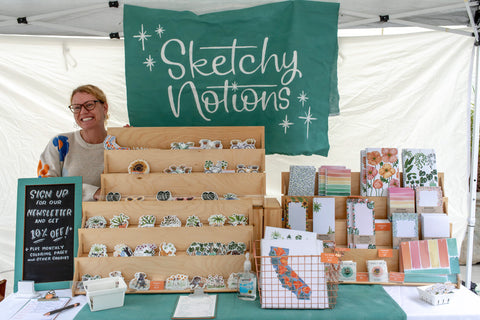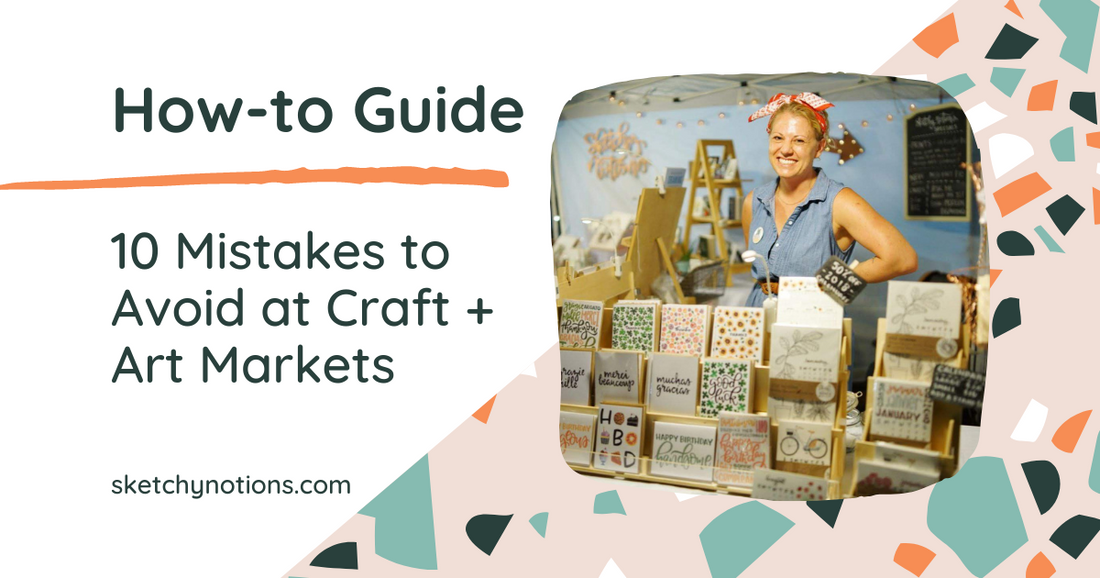Things have come a long way since then and I've learned a lot from trial and error so I wanted to put together a guide of some recommendations... things I used to do in the past (or this summer) and things I've observed other folks doing. I wish I had know a lot of these things earlier on while doing markets so I hope y'all might find them helpful!

Here are my 10 mistakes to avoid at craft fairs or art markets:
1. Not having ways to find you after the market: Once a customer leaves your booth, how are they going to find you after? Did you have your brand name big enough so they'd remember it or business cards available? Especially if you're trying to redirect to your standalone site instead of them trying to find you on Etsy, having business cards and your brand name visible is crucial to get buyers to find you later.
I used to print my own business cards at home and now get them in bulk from Zazzle (you can get 30% off with my referral link here). Having a newsletter sign up with a discount incentive is also really helpful to not only convert the sale during the market but also keep them coming back to your shop online and to future markets!
2. Not investing in quality booth basics: I was at a market recently and saw a booth using a fitted bed sheet as a table cloth. It doesn't matter how nice your products are... shoppers can tell you have a bed sheet underneath them. I understand the need to save money in the very beginning. For my first markets I would borrow tables, tablecloths and umbrellas from family and friends. Once I made some money I thrifted a nicer tablecloth and decorated it to be on brand. I have since upgraded and invested in quality display items (you can see lots of my recs on my Amazon list here). It can be tricky to be cohesive on a budget but it goes a long way in displaying your products, appealing to potential customers and appearing more professional. You can DIY a lot for cheap, like table runners and signs!
Also... unless your brand really needs a colored canopy to stay on brand, try to get a white canopy as they make the best lighting in your booth for your products! My first one was blue and the lighting it cast on my prints did not do them any favors.
In conjunction with booth basics... BUY ENOUGH WEIGHTS FOR YOUR CANOPY. I don't care if the market didn't require them, I have seen too many canopies get lifted during a breeze and wreck their products (or neighbor's products). Buy weights. Buy more weight than you think you'll need. Your anxiety (and the anxiety of those around you) will be better for it.
3. Not displaying your products in a flattering or organized way: Oof. I learned this one over time. It's not good to just have your products flat across the table. I used to have cards in bins to flip through just on the table without any height or visual interest to keep folks' eyes moving around. I then graduated to custom card racks that folded flat which helped bring some height, highlighted my variety of cards better and gave me more room on the table for other products.
Have height, keep their eye moving while still keeping things organized and uncluttered. These raised plate racks are great for prints. I like to group similar products together or similar price points. High price items like originals and sketchbooks are always close together and stickers are all together on a rack with sticker sheets. I also try to keep my bins cohesive... all pine for the wood and copper baskets for any metal.

4. Not offering enough payment options: Full disclosure... I was guilty of violating this mistake just this summer. My Shopify card reader was an older model so I couldn't take Apple pay. It was more frustrating for me than my customers having to say the same speech over and and over explaining how my card reader was a generation too old. I finally updated it and it's been so nice having a smoother check out.
I also don't like accepting Venmo because remitting taxes from Venmo looks tedious but I'm happy to let someone pay me via Zelle as a last resort to them not having cash, cards, or cards loaded on their phone! Having a POS synced directly to my inventory on Shopify has been really helpful too.
Make sure you have a cash box to keep your change in too. I always bring more change than I need. A portable charger can also really come in handy since the portable POS card readers can drain your phone battery.
5. Letting people bargain or negotiate your prices: I get it, sometimes you really just want to make the sale. But you don't have to accept people bargaining or lowballing you and your pricing. I have plenty of people scoff at my sketchbook prices but I'd rather sell them to the right customer for the price that's fair to me, my skills and my invested time than give it away for the sake of a sale.
Instead of accepting negotiations, try offering deals (buy 6 cards for $28) or bundles (matching notebook, notepad and bundle for $X). It's a great way to give someone a deal, and possibly increase your AOV (average order value). Just make sure you know your margins and don't undersell your value, skill or product quality.
6. Not charging enough: Pricing stuff his hard, especially handmade goods. But you know what's harder? Not making a profit or feeling like you gave away a product because you didn't charge enough. I was definitely selling originals for under $50 at one point... I was so nervous that people would balk at my prices if I charged how much I actually felt I should.
I've since gotten over that and started valuing my skills and product accordingly. Are my prices for originals and sketchbooks for everyone? Not at all and that's okay! I also like to provide multiple price points within my booth for different budgets... while originals are $200+, they can get a print instead for only $20 ;)
Still feel icky asking for more money? Try raising the price for the market and simultaneously offering a discount for newsletter sign ups. This way the buyer is paying closer to your desired price but they feel like they got a deal getting 10% off AND you have a touch point to reach them after the sale!

7. Not displaying prices: I definitely didn't do this until this past Holiday season. Not displaying obvious prices in multiple places can leave a lot open to the imagination and won't start any conversations with potential buyers either. By having individual tags, category tags on bins/shelves or clip boards of the whole booth pricing can really help leave less potential for a shopper filling in the gap of what they think your unique item could cost. Lots of people are too shy to ask to ask the price so answering their question before it can be asked is very helpful. Having prices in multiple places is helpful too. It doesn't guarantee they'll see or read them but it helps to cover your bases!
8. Sitting down the whole time: I see this ALL the time, folks sitting behind their displays out of sight. I'm an introvert and I get it... markets are exhausting standing all day and having to people all day. But when you're sitting down, you don't look engaged and often your booth doesn't look open for business! Especially if you're sitting down on your phone. Big no-no.
Standing implies your booth is open for business and you're there to answer questions (and take their money ;)) As a shopper, I often don't even approach a booth if I don't see the seller present (if they're not there, I can't buy anything) so try to remain visible, or get a tall chair or stool if you know you're going to need to rest your legs during the day.
9. Packing out early: Just don't do it, okay? Unless there's a general consensus from all the vendors due to weather or bad foot traffic OR it's been okayed with the market hosts. Everyone has a slow or bad market from time to time, it happens. But packing out early can signal to shoppers that the market is over early, ruining potential sales for your fellow vendors. Plus, plenty of markets will not let you come back if you pack out early!
Instead of wallowing in downtime, think of how you can best use that down time. I always pack a sketchbook so I can doodle new product ideas or sketch how to better set up my booth at the next market. And sometimes a market just isn't a good fit for your goods! Take that down time to assess what can be improved or if you're in the right place for your target audience.
10. Not making friends with your neighbors: Hopefully your market will go well enough that you'll want to do another market! Having market friends comes in handy, not only for being able to have an extra set of eyes while you run to the restroom... in return, offer that to your neighbors and be a good neighbor! I've had very inconsiderate neighbors over the years but the majority are really love... and market friends are a great network of knowledge! They know other markets and retailers and makers you could look into, and it's just fun to see a familiar face when you attend another market.

Bonus! I remembered another tip... keep a note in your phone with a checklist of everything you need to bring. Everything from the canopy and canopy walls, getting change and snacks to packing business cards and sunscreen. I've been doing markets for years and I still run through the same checklist the week of every market! I also make notes on that same list of things I'd like to remember for the next market!
What other market mistakes do you try to avoid?



1 comment
Thank you for jotting down these points. Really helpful. Totally with you on the pricing and not sitting down.